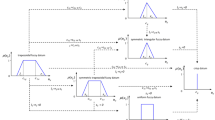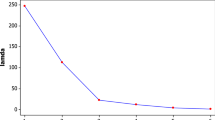Abstract
Fuzzy modeling and fuzzy statistics provide useful tools for handling empirical situations affected by vagueness and imprecision in the data. Several fuzzy statistical models and methods (e.g., fuzzy regression, fuzzy principal component analysis, fuzzy clustering) have been developed over the years. Generally the standard LR-fuzzy data representation has been used in these methods. However, several empirical contexts, such as human ratings and decision making, may show more complex fuzzy structures which cannot be successfully modeled by the LR representation. In all these cases another type of fuzzy data representation, the so-called LHIR representation, should be preferred instead. In particular, this novel representation allows to handle with fuzzy data which are characterized by non-convex membership functions. In this paper, we address the problem of summarizing large datasets characterized by two-mode non-convex fuzzy data. We introduce a novel dimension reduction technique (NCFCA) based on the framework of Component Analysis and Least squares programming. Finally, to better highlight some important characteristics of the proposed model, we apply NCFCA to three empirical datasets concerning behavioral and socio-economic issues.











Similar content being viewed by others
Notes
Note, however, that the membership functions always contribute to the orientation of the axes in \(\mathbb {R}^p\) even if they are not directly illustrated in the graphical representation.
References
Abdi H, Williams LJ (2010) Principal component analysis. Wiley Interdiscip Rev Comput Stat 2(4):433–459
van den Berg RA, Hoefsloot HC, Westerhuis JA, Smilde AK, van der Werf MJ (2006) Centering, scaling, and transformations: improving the biological information content of metabolomics data. BMC Genomics 7(1):142
Bloch I (1999) On fuzzy distances and their use in image processing under imprecision. Pattern Recognit 32(11):1873–1895
Bro R, Smilde AK (2003) Centering and scaling in component analysis. J Chemom 17(1):16–33
Calcagnì A, Lombardi L (2014) Dynamic fuzzy rating tracker (DYFRAT): a novel methodology for modeling real-time dynamic cognitive processes in rating scales. Appl Soft Comput 24(1):948–961
Calcagnì A, Lombardi L, Pascali E (2014) Non-convex fuzzy data and fuzzy statistics: a first descriptive approach to data analysis. Soft Comput 18(8):1575–1588
Cazes P, Chouakria A, Diday E, Schektrman Y (1997) Entension de l’analyse en composantes principales à des données de type intervalle. Revue de Stat appliquée 45(3):5–24
Ciavolino E, Salvatore S, Calcagnì A (2014) A fuzzy set theory based computational model to represent the quality of inter-rater agreement. Qual Quant 48(4):2225–2240
Coppi R, Giordani P, D’Urso P (2006) Component models for fuzzy data. Psychometrika 71(4):733–761
Diamond P (1988) Fuzzy least squares. Inf Sci 46(3):141–157
Douzal-Chouakria A, Billard L, Diday E (2011) Principal component analysis for interval-valued observations. Stat Anal Data Min 4(2):229–246
Dubois D, Prade HM, Farreny H, Martin-Clouaire R, Testemale C (1988) Possibility theory: an approach to computerized processing of uncertainty, vol 2. Plenum press, New York
Eriksson L (2006) Multi-and megavariate data analysis. MKS Umetrics AB
Facchinetti G, Pacchiarotti N (2006) Evaluations of fuzzy quantities. Fuzzy Sets Syst 157(7):892–903
Garibaldi JM, Musikasuwan S, Ozen T, John RI (2004) A case study to illustrate the use of non-convex membership functions for linguistic terms. In: Fuzzy systems, 2004. Proceedings 2004 IEEE International Conference on, IEEE, vol 3. pp 1403–1408
Giordani P (2010) Three-way analysis of imprecise data. J Multivar Anal 101(3):568–582
Giordani P, Kiers HA (2004) Principal component analysis of symmetric fuzzy data. Comput Stat Data Anal 45(3):519–548
Giordani P, Kiers HA (2007) Principal component analysis with boundary constraints. J Chemom 21(12):547–556
Greene J, Haidt J (2002) How (and where) does moral judgment work? Trends Cogn Sci 6(12):517–523
Hanss M (2005) Applied fuzzy arithmetic. Springer
Hastie T, Tibshirani R, Friedman J (2001) The elements of statistical learning theory. Springer
Hesketh T, Pryor R, Hesketh B (1988) An application of a computerized fuzzy graphic rating scale to the psychological measurement of individual differences. Int J Man Mach Stud 29(1):21–35
Irpino A, Lauro C, Verde R (2003) Visualizing symbolic data by closed shapes. In: Between data science and applied data analysis, Springer, pp 244–251
Jahanshahloo GR, Lotfi FH, Izadikhah M (2006) Extension of the topsis method for decision-making problems with fuzzy data. Appl Math Comput 181(2):1544–1551
Johnson A, Mulder B, Sijbinga A, Hulsebos L (2012) Action as a window to perception: measuring attention with mouse movements. Appl Cogn Psychol 26(5):802–809
Kaiser HF (1958) The varimax criterion for analytic rotation in factor analysis. Psychometrika 23(3):187–200
Kiers HA (1997) Techniques for rotating two or more loading matrices to optimal agreement and simple structure: a comparison and some technical details. Psychometrika 62(4):545–568
Kiers HA (2002) Setting up alternating least squares and iterative majorization algorithms for solving various matrix optimization problems. Comput Stat Data Anal 41(1):157–170
Kiers HA (2004) Bootstrap confidence intervals for three-way methods. J Chemom 18(1):22–36
Kiers HA, ten Berge JM (1989) Alternating least squares algorithms for simultaneous components analysis with equal component weight matrices in two or more populations. Psychometrika 54(3):467–473
Lalla M, Facchinetti G, Mastroleo G (2005) Ordinal scales and fuzzy set systems to measure agreement: an application to the evaluation of teaching activity. Qual Quant 38(5):577–601
Lauro CN, Palumbo F (2000) Principal component analysis of interval data: a symbolic data analysis approach. Comput Stat 15(1):73–87
Le-Rademacher J, Billard L (2012) Symbolic covariance principal component analysis and visualization for interval-valued data. J Comput Graph Stat 21(2):413–432
Magnuson JS (2005) Moving hand reveals dynamics of thought. Proc Natl Acad Sci USA 102(29):9995–9996
Meredith W, Millsap RE (1985) On component analyses. Psychometrika 50(4):495–507
Millsap RE, Meredith W (1988) Component analysis in cross-sectional and longitudinal data. Psychometrika 53(1):123–134
Reuter U (2008) Application of non-convex fuzzy variables to fuzzy structural analysis. Soft methods for handling variability and imprecision. pp 369–375
Stöber J, Joormann J (2001) A short form of the worry domains questionnaire: construction and factorial validation. Personal Individ Differ 31(4):591–598
Taheri SM (2003) Trends in fuzzy statistics. Austrian J Stat 32(3):239–257
Trefethen LN, Bau D (1997) Numerical linear algebra. Siam, p 50
Viertl R (2011) Statistical methods for fuzzy data. Wiley
Weber EU, Johnson EJ (2009) Mindful judgment and decision making. Ann Rev Psychol 60:53–85
Yang MS, Ko CH (1996) On a class of fuzzy c-numbers clustering procedures for fuzzy data. Fuzzy Sets Syst 84(1):49–60
Zimmermann HJ (2001) Fuzzy set theory-and its applications. Springer
Author information
Authors and Affiliations
Corresponding author
Additional information
Communicated by V. Loia.
Electronic supplementary material
Below is the link to the electronic supplementary material.
Rights and permissions
About this article
Cite this article
Calcagnì, A., Lombardi, L. & Pascali, E. A dimension reduction technique for two-mode non-convex fuzzy data. Soft Comput 20, 749–762 (2016). https://doi.org/10.1007/s00500-014-1538-8
Published:
Issue Date:
DOI: https://doi.org/10.1007/s00500-014-1538-8




